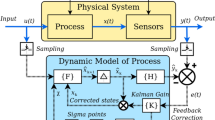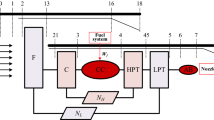Abstract
Turboshaft engines are different from each other due to manufacturing and installation tolerances. Hence, it is difficult to draw out the physical model from the average component maps and design points to represent the performance of the individual engine. The available test-bed data is usually less than the number of correction coefficients to update the maps, and it is the underdetermined state optimization issue. In this paper, we propose a novel reduced-order optimization, namely PSO-EKF algorithm, combined with prior state estimation for non-linear model correction of the turboshaft engine. This method combines the advantages of PSO and extended Kalman filter (EKF). PSO-EKF method converts partial parameters optimized by PSO into parameters directly solved by EKF. The order of optimization space is reduced. Using the correction coefficient function, a stability improvement strategy is designed to ensure the stability of the optimization process. Compared with the GA and PSO algorithms, experimental verification shows that the method has a faster convergence speed and smaller model error than the general PSO. After the performance map is updated by this method, the error of outputs of the individual model is within 1.4 %.
Similar content being viewed by others
Abbreviations
- PSO :
-
Particle swarm optimization algorithm
- EKF :
-
Extended Kalman filter
- GA :
-
Genetic algorithm
- PSO-EKF :
-
Kelvin temperature scale
- Ma :
-
Match number
- H :
-
Altitude
References
H. Zhou, J. Huang and F. Lu, Parsimonious kernel recursive least squares algorithm for aero-engine health diagnosis, IEEE Access, 6 (2018) 74687–74698, DOI: https://doi.org/10.1109/ACCESS.2018.2882824.
J. Lu, J. Huang and F. Lu, Kernel extreme learning machine with iterative picking scheme for failure diagnosis of a turbofan engine, Aerospace Science and Technology, 96 (2020) 105539, https://doi.org/10.1016/j.ast.2019.105539.
T. Brotherton et al., eSTORM: Enhanced self tuning on-board real-time engine model, 2003 IEEE Aerospace Conference Proceedings, Big Sky, USA (2003) 3075–3086, DOI: https://doi.org/10.1109/AERO.2003.1234150.
Y. Huang et al., A modified fusion model-based/data-driven model for sensor fault diagnosis and performance degradation estimation of aero-engine, Measurement Science and Technology, 33(8) (2022) 085105, DOI: https://doi.org/10.1088/1361-6501/ac60.
Y. Yu, L. Chen, F. Sun and C. Wu, Neural-network based analysis and prediction of a compressor’s characteristic performance map, J. Sci. Appl. Energy, 81(1) (2007) 48–55, https://doi.org/10.1016/j.apenergy.2006.04.005.
W. Zhou et al., A novel data-driven-based component map generation method for transient aero-engine performance adaptation, Aerospace, 9(8) (2022) 442, https://doi.org/10.3390/aerospace9080442.
C. Pu and W. Zhou, Aero-engine model correction technology based on adaptive neural network, Journal of Physics: Conference Series, 2187 (2022) 012064, DOI: https://doi.org/10.1088/1742-6596/2187/1/012064.
R. H. Luppold, G. W. Gallops, L. J. Keer and J. Roman, Estimating in-flight engine performance variations using Kalman filter concepts, 25th Joint Propulsion Conference, Monterey, USA (1989).
J. Kennedy and R. Eberhart, Particle swarm optimization, Proceedings of ICNN’95-International Conference on Neural Networks, Perth, Austrailia, 4 (1995) DOI: https://doi.org/10.1109/ICNN.1995.488968.
R. Eberhart and J. Kennedy, A new optimizer using particle swarm theory, Proceedings of the Sixth International Symposium on Micro Machine and Human Science, Nagoya, Japan (2002) DOI: https://doi.org/10.1109/MHS.1995.494215.
B. Lambiris, K. Mathioudakis, A. Stamatis and K. Papailiou, Adaptive modeling of jet engine performance with application to condition monitoring, Journal of Propulsion and Power, 10 (6) (1994) https://doi.org/10.2514/3.23828.
C. Kong, S. Kho and J. Ki, Component map generation of a gas turbine using genetic algorithms, Proceedings of the ASME Turbo Expo 2004: Power for Land, Sea, and Air. Volume 7: Turbo Expo 2004, Vienna, Austria (2004) 469–474, https://doi.org/10.1115/GT2004-53736.
C. Kong, S. Kho and J. Ki, Component map generation of a gas turbine using genetic algorithms, J. Eng. Gas Turbines Power, 128(1) (2004) 92–96, https://doi.org/10.1115/1.2032431.
E. Lo Gatto, Y. G. Li and P. Pilidis, Gas turbine off-design performance adaptation using genetic algorithm, Proceedings of the ASME Turbo Expo 2006: Power for Land, Sea, and Air. Volume 2: Aircraft Engine; Ceramics; Coal, Biomass and Alternative Fuels; Controls, Diagnostics and Instrumentation; Environmental and Regulatory Affairs, Barcelona, Spain (2006) 551–560, https://doi.org/10.1115/GT2006-90299.
Y.-G. Li et al., Multiple-point adaptive performance simulation tuned to aeroengine test-bed data, Journal of Propulsion and Power, 25(3) (2009) 635–641, https://doi.org/10.2514/1.38823.
Y. Li, M. F. Abdul Ghafir, L. Wang, R. Singh, K. Huang, X. Feng and W. Zhang, Improved multiple point nonlinear genetic algorithm based performance adaptation using least square method, J. Eng. Gas Turbines Power, 134(3) (2012) 031701, https://doi.org/10.1115/1.4004395.
A. Stamatis, K. Mathioudakis and K. D. Papailiou, Adaptive simulation of gas turbine performance, J. Eng. Gas Turbines Power, 112(2) (1990) 168–175, https://doi.org/10.1115/1.2906157.
M. A. R. Nascimento, The selective bleed variable cycle engine, Dissertation, Cranfield Institute of Technology, UK (1992) http://dspace.lib.cranfield.ac.uk/handle/1826/7359.
C. Kong and J. Ki, Components map generation of gas turbine engine using genetic algorithms and engine performance deck data, J. Eng. Gas Turbines Power, 129(2) (2007) 312–317, https://doi.org/10.1115/1.2436561.
M. Espana, On the estimation algorithm for adaptive performance optimization of turbofan engines, 29th Joint Propulsion Conference and Exhibit, Monterey, CA, USA (1993).
Y. G. Li, P. Pilidis and M. A. Newby, An adaptation approach for gas turbine design-point performance simulation, J. Eng. Gas Turbines Power, 128(4) (2006) 789–795, https://doi.org/10.1115/1.2136369.
B. Roth, D. L. Doel, D. Mavris and D. Beeson, High-accuracy matching of engine performance models to test data, Proceedings of the ASME Turbo Expo 2003, collocated with the 2003 International Joint Power Generation Conference. Volume 1: Turbo Expo 2003, Atlanta, Georgia, USA (2003) 129–137, https://doi.org/10.1115/GT2003-38784.
B. A. Roth, D. L. Doel and J. J. Cissell, Probabilistic matching of turbofan engine performance models to test data, Proceedings of the ASME Turbo Expo 2005: Power for Land, Sea, and Air. Volume 1: Turbo Expo 2005, Reno, Nevada, USA (2005) 541–548, https://doi.org/10.1115/GT2005-68201.
Z. Yong, L. Benwei, Z. Yun and Y. Xinyi, Nonlinear adaptation for performance model of an aero engine using QPSO, 2016 IEEE Information Technology, Networking, Electronic and Automation Control Conference, Chongqing, China (2016) 957–961, DOI: https://doi.org/10.1109/ITNEC.2016.7560504.
R. Qian et al., Research on model correction of turbofan engine based on quantum-behaved particle swarm optimization, IOP Conference Series: Materials Science and Engineering, 751 (2020) 012026, DOI: https://doi.org/10.1088/1757-899X/751/1/012026.
S. Liu, W. Wang, J. Bai and S. Dai, Study on component characteristic correction algorithm of turbofan engine, Research Square (2021) https://doi.org/10.21203/rs.3.rs-195963/v1 (preprint).
S. Lu, W. Zhou, J. Huang, F. Lu and Z. Chen, A novel performance adaptation and diagnostic method for aero-engines based on the aerothermodynamic inverse model, Aerospace, 9(1) (2022) 16, https://doi.org/10.3390/aerospace9010016.
S. Pang, Q. Li and H. Feng, A hybrid onboard adaptive model for aero-engine parameter prediction, Aerospace Science and Technology, 105 (2020) 105951, https://doi.org/10.1016/j.ast.2020.105951.
S. Pang, Q. Li, H. Feng and H. Zhang, Joint steady state and transient performance adaptation for aero engine mathematical model, IEEE Access, 7 (2019) 36772–36787, DOI: https://doi.org/10.1109/ACCESS.2019.2905865.
L. I. Shaochen, T. Hailong and C. Min, A new component maps correction method using variable geometric parameters, Chinese Journal of Aeronautics, 34(4) (2021) 360–374, https://doi.org/10.1016/j.cja.2020.08.021.
Q. Zheng, Y. Wang, C. Jin and H. Zhang, Aero-engine dynamic model based on an improved compact propulsion system dynamic model, Proceedings of the Institution of Mechanical Engineers, Part I: Journal of Systems and Control Engineering, 235(7) (2021) 1036–1045, DOI: https://doi.org/10.1177/0959651820984081.
H. Sheng, T. Zhang and W. Jiang, Full-range mathematical modeling of turboshaft engine in aerospace, International Journal of Turbo & Jet-Engines, 33(4) (2016) 309–317, https://doi.org/10.1515/tjj-2015-0033.
Z. Zhu, Q. Li and Y. Wang, Correction of aeroengine model based on differential evolution algorithm, Aeroengine, 42(1) (2016) 53–58, DOI: https://doi.org/10.13477/j.cnki.aeroengine.2016.01.011.
C. Kong, J. Ki and M. Kang, A new scaling method for component maps of gas turbine using system identification, J. Eng. Gas Turbines Power, 125(4) (2003) 979–985, https://doi.org/10.1115/1.1610014.
C. Kong, S. Kho and J. Ki, Component map generation of a gas turbine using genetic algorithms, J. Eng. Gas Turbines Power, 128(1) (2006) 92–96, https://doi.org/10.1115/1.2032431.
Y. Li, M. F. Abdul Ghafir, L. Wang, R. Singh, K. Huang, X. Feng and W. Zhang, Improved multiple point nonlinear genetic algorithm based performance adaptation using least square method, J. Eng. Gas Turbines Power, 134(3) (2012) 031701, https://doi.org/10.1115/1.4004395.
E. Tsoutsanis, Y. G. Li, P. Pilidis and M. Newby, Part-load performance of gas turbines: part i — a novel compressor map generation approach suitable for adaptive simulation, Proceedings of the ASME 2012 Gas Turbine India Conference, Mumbai, Maharashtra, India, 1 (2012) 733–742, https://doi.org/10.1115/GTINDIA2012-9580.
E. Tsoutsanis, Y. G. Li, P. Pilidis and M. Newby, Part-load performance of gas turbines: part ii — multi-point adaptation with compressor map generation and GA optimization, Proceedings of the ASME 2012 Gas Turbine India Conference, Mumbai, Maharashtra, India, 1 (2012) 743–751, ASME, https://doi.org/10.1115/GTINDIA2012-9581.
G. Alberto Misté and E. Benini, Turbojet engine performance tuning with a new map adaptation concept, J. Eng. Gas Turbines Power, 136(7) (2014) 071202, https://doi.org/10.1115/1.4026548.
Q. Yang, S. Li and Y. Cao, A new component map generation method for gas turbine adaptation performance simulation, J. Mech. Sci. Technol., 31 (2017) 1947–1957, https://doi.org/10.1007/s12206-017-0344-5.
Acknowledgments
We are grateful for the financial support of the National Science and Technology Major Project (No. 2017-I-0006-0007).
Author information
Authors and Affiliations
Corresponding author
Additional information
Xinhao Han received the B. Eng. in Aerospace Propulsion Engineering from the Nanjing University of Aeronautics and Astronautics (NUAA), Nanjing, China, in 2020, where studied as a postgraduate student, from 2020 to 2023. He is currently pursuing the Ph.D. in Power Machinery and Engineering with NUAA. His current research interests are in fields of gas turbine engine modelling and control.
Jinquan Huang received the M.S. and Ph.D. in Aerospace Propulsion System Theory and Engineering from the Nanjing University of Aeronautics and Astronautics, Nanjing, China, in 1987 and 1998, respectively. He has been a Professor with the College of Energy and Power Engineering, Nanjing University of Aeronautics and Astronautics, since 1999. His current research interests include gas turbine engine modeling, control, and health management.
Xin Zhou received the Ph.D. degree in Aeronautical and Astronautical Propulsion Theory and Engineering from Nanjing University of Aeronautics and Astronautics, China in 2021. Her current research interests include aeroengine modeling and intelligent control.
Zelong Zou received the B. Eng. in Aerospace Propulsion Engineering from the Nanjing University of Aeronautics and Astronautics (NUAA), Nanjing, China, in 2019, where studied as a postgraduate student, from 2021 to 2023. He is currently pursuing the Ph.D. in Power Machinery and Engineering with NUAA. His research interests are in gas turbine engine modelling.
Rights and permissions
About this article
Cite this article
Han, X., Huang, J., Zhou, X. et al. A novel, reduced-order optimization method for nonlinear model correction of turboshaft engines. J Mech Sci Technol 38, 2103–2122 (2024). https://doi.org/10.1007/s12206-024-0340-5
Received:
Revised:
Accepted:
Published:
Issue Date:
DOI: https://doi.org/10.1007/s12206-024-0340-5




